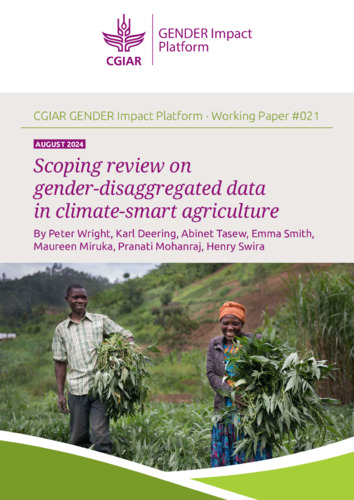Scoping review on gender-disaggregated data in climate-smart agriculture: CGIAR GENDER Impact Platform Working Paper #21
Abstract
The focus of this scoping review is to understand the extent gender-disaggregated data are available in climate-smart agriculture (CSA) programming, identify gaps in the collection and analysis of this data, and suggest ways to bridge those gaps to reduce gender inequalities that may prevent women and girls from benefiting from CSA programming. The methodology involves a qualitative approach that uses a desk review of selected literature and key informant interviews. To identify relevant literature, CARE used key words to conduct a text search that included peer-reviewed and published literature, gray literature, official data sets and sources and other qualitative evidence. The key informant interviews included a convenience sample of 11 key informants representing multilateral agencies, an international nongovernment organization program, a local nongovernment organization (NGO) program, government programs, a national agricultural research institute, an international research institute, and a private sector program. The key informant interviews were conducted to address several objectives, including assessing gaps in collecting, analyzing, and using disaggregated data for gender, social, economic and demographic intersectional variables in CSA programming; identifying indicators and tools used to measure project outcomes and impacts; and understanding the periodicity of data collection and people involved in such data collection.
The CSA framework has three primary objectives: production, resilience and mitigation. Gender equality, social inclusion and other equity-oriented objectives are not included in these three objectives. Gender was retrospectively included as something that should be “mainstreamed” in the pursuit of the three primary objectives. The Food and Agriculture Organization’s (FAO) seminal paper on CSA in 2010 did not address gender, gender equality or equity. As a result, there are no tools, methods or metrics that address gender equality in the paper. The weakness of the CSA framework has become more apparent over time, and the discourse and practice on gender in agriculture has progressed from sensitivity and mainstreaming toward responsiveness and eventually transformation. However, there has been no commitment to specific actions and measurement systems that would track progress, illustrating the lack of expectation and ambition for advancing gender equality within CSA.

